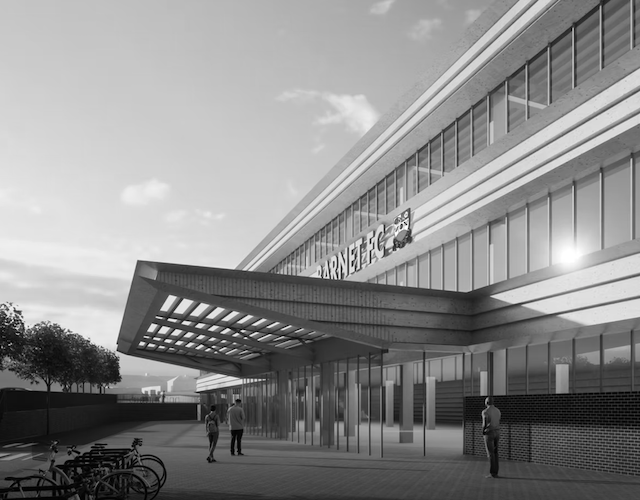Barnet Football Club has returned to the Football League, topping the National League after narrowly missing out on promotion two years running. Could that success be matched off the field, as support grows for the club’s bid to return to its historic Underhill home?
It seemed a long shot when plans for a new stadium – on a Green Belt site – were first unveiled. But an initially unlikely coalition of fans and local amenity organisations, plus the potential impact of the government’s new “grey belt” policy look to be narrowing the odds ahead of a key council planning meeting, to possibly be held as soon as 10 June.
Barnet played its final game at Underhill, its home for more than a century, back in 2013. It went into exile in Harrow after clashing with the council over development plans and failing to find an alternative site. Now, owner Tony Kleanthous is proposing a new 7,000-seat stadium on council-owned playing fields just to the south of the old site.
The plan would secure Barnet FC’s future and benefit a community in which it has played a central role for generations, the club says. Development in the Green Belt has previously been determinedly resisted in the suburban borough, but a vigorous Bring Barnet Back campaign, independent from the club, is challenging that orthodoxy.
First to declare was the venerable Barnet Residents Association, concluding that the club “returning to the area and the facilities they offer would be of considerable value to the wider community and would outweigh the negative aspects of the application”.
There was “nothing intrinsically attractive” about the chosen site, they added. Existing facilities would remain, new landscaping and “enhanced biodiversity” would minimise the stadium’s impact, and there would be still be “sufficient green” for dog walking and “other recreational purposes”.
The influential Barnet Society, defender of the Green Belt since 1945, then added its qualified support: “We wholeheartedly support the principle of Barnet Football Club returning closer to its historic roots, and we can see some potential benefits for Chipping Barnet as well as the Club.”
The society does have reservations about loss of open space – which it said should be restored “if football use fails” – increased traffic, the need for the club to offer benefits to the wider community as well as to its fans, and the extent of the new stadium’s economic boost to the area.
But it shared the residents association’s opinion of the site’s current “limited” contribution to biodiversity, saying that an upgrade would be “at least as attractive” as the present playing fields. If its concerns were addressed, it concluded, “we would be pleased to support this application”.
Last week, local ward councillor Tim Roberts, first elected in 2014, signed up too. “The majority of Underhill residents that I speak with are in support of Barnet FC returning,” he said in a statement posted by the Bring Barnet Back campaign. “I used to walk my children down to the Underhill stadium for years to watch Barnet play…I am in support of Barnet FC playing their football in a new purpose-built stadium in Underhill.”
As Barnet’s planners ponder their recommendation, they will also be considering whether the proposed site now meets the government’s rules for defining “grey belt” as land, “previously developed” or not which does not “strongly contribute” to three of the five Green Belt purposes set out in national planning policy: to check the unrestricted sprawl of large built-up areas, prevent neighbouring towns merging into one another or preserve the setting and special character of historic towns.
If it does meet that definition, further planning policy hurdles remain. In particular, the scheme would need to show that there is a “demonstrable unmet need” for the type of development proposed, and that it would not “fundamentally undermine the purposes (taken together)” of the remaining Green Belt across the borough. Leaping those hurdles would make the scheme is no longer “inappropriate development” in the Green Belt and that “very special circumstances” would no longer required to justify approval.
How the new grey belt policy, yet to be tested in London, might affect the club’s proposals will be a matter for interpretation, by planners, lawyers, councillors and ultimately, perhaps, the planning inspectorate and the courts. And the club is still battling against tough opposition campaigning to save “valuable green space”. But off the field as well as on, there’s all to play for.
OnLondon.co.uk provides unique coverage of the capital’s politics, development and culture with no paywall and no ads. Support it for just £5 a month or £50 a year and get things for your money other people won’t. Details HERE. Follow Charles Wright on Bluesky. Image from Bring Barnet Back.
